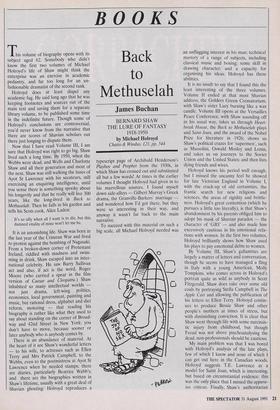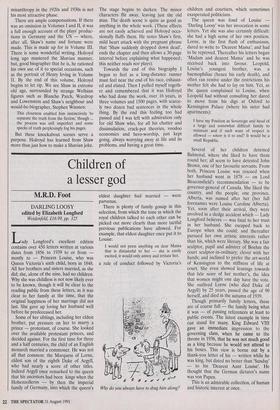BOOKS
Back to Methuselah
James Buchan
BERNARD SHAW THE LURE OF FANTASY 1918-1950 by Michael Holroyd Chatto & Windus, £21, pp. 544 This volume of biography opens with its subject aged 62. Somebody who didn't know the first two volumes of Michael Holroyd's life of Shaw might think the enterprise was an exercise in academic pedantry, and far too long for an un- fashionable dramatist of the second rank.
Holroyd does at least dispel any academic fug. He said long ago that he was keeping footnotes and sources out of the main text and saving them for a separate library volume, to be published some time in the indefinite future. Though some of Holroyd's conclusions are controversial, you'd never know from the narrative that there are scores of Shavian scholars out there just longing to dispute them.
Now that I have read Volume HI, I am sure that Holroyd was right to go big. Shaw lived such a long time. By 1950, when the Webbs were dead, and Wells and Charlotte Shaw and all their generation and most of the next, Shaw was still walking the lanes of Ayot St Lawrence with his secateurs, still exercising an enquiring intelligence, until you sense there is something spooky about his longevity and that he really will live 300 years, like the long-lived in Back to Methuselah. Then he falls in his garden and tells his Scots cook, Alice Laden: It's so silly when all I want is to die, but this damned vitality of mine won't let me be.
It is an astonishing life. Shaw was born in the last year of the Crimean War and lived to protest against the bombing of Nagasaki. From a broken-down corner of Protestant Ireland, riddled with madness and swim- ming in drink, Shaw escaped into an inter- national celebrity. He saw Barry Sullivan act and also, if act is the word, Roger Moore (who carried a spear in the film version of Caesar and Cleopatra.) Shaw inhabited so many intellectual worlds not just drama, left-wing politics, economics, local government, painting and music, but rational dress, alphabet and diet reform, motoring — that reading his biography is rather like what they used to say about standing on the corner of Broad- way and 42nd Street in New York: you don't have to move, because sooner or later anybody who is anybody comes by.
There is an abundance of material. At the heart of it are Shaw's wonderful letters — to his wife, to actresses such as Ellen Terry and Mrs Patrick Campbell, to the Webbs, even to the postmistress at Ayot St Lawrence when he needed stamps; there are diaries, particularly Beatrice Webb's; and there are the biographies written in Shaw's lifetime, usually with a great deal of Shavian ghosting: Holroyd reproduces a
typescript page of Archibald Henderson's Playboy and Prophet from the 1930s, in which Shaw has crossed out and substituted all but a few words! At times in the earlier volumes I thought Holroyd had given in to his marvellous sources. I found myself down side-alleys — Gilbert Murray's Greek drama, the Granville-Barkers' marriage and wondered how I'd got there, but they were so interesting in their way, and anyway it wasn't far back to the main narrative.
To succeed with this material on such a big scale, all Michael Holroyd needed was an unflagging interest in his man; technical mastery of a range of subjects, including classical music and boxing; some skill in drawing character; and a capacity for organising his ideas. Holroyd has these abilities.
It is no insult to say that I found this the least interesting of the three volumes. Volume H ended at that most Shavian address, the Golders Green Crematorium, with Shaw's sister Lucy burning like a wax candle. Volume HI opens at the Versailles Peace Conference, with Shaw sounding off in his usual way, takes us through Heart- break House, the Back to Methuselah plays and Saint Joan, and the award of the Nobel Prize for literature in 1926; shows us Shaw's political crazes for `supermen', such as Mussolini, Oswald Mosley and Lenin, and takes us on journeys to the Soviet Union and the United States; and then lists dying friends and wives.
Holroyd knows his period well enough, but I missed the uncanny feel he showed for late Victorian England in Volume I, with the crack-up of old certainties, the frantic search for new religions and sciences, the areas of rigidity and brittle- ness. Holroyd's great contention (which he pursues a little too literally), is that Shaw's abandonment by his parents obliged him to adopt his mask of Shavian paradox — the character of `GBS' — and also made him excessively cautious in his emotional rela- tions with women. In the first two volumes, Holroyd brilliantly shows how Shaw used his plays to pay emotional debts to women.
By Volume III, Shaw's gallantries are largely a matter of letters and conversation, though he seems to have managed a fling in Italy with a young American, Molly Tompkins, who comes across in Holroyd's portrait quite as wild as anybody in Scott Fitzgerald. Shaw does rake over some old coals by portraying Stella Campbell in The Apple Cart and allowing the publication of his letters to Ellen Terry. Holroyd contin- ues to produce Bessie Shaw and other people's mothers at times of stress, but with diminishing conviction. It is clear that Shaw went through life with some narcissis- tic injury from childhood, but though Freud was not above psychoanalysing the dead, non-professionals should be cautious.
My main problem was that I was bored with Holroyd's analysis of the late plays, few of which I know and none of which I can get out here in the Canadian woods. Holroyd suggests T.E. Lawrence as a model for Saint Joan, which is interesting, but based on circumstantial evidence: this was the only place that I missed the appara- tus criticus. Finally, Shaw's authoritarian
misanthropy in the 1920s and 1930s is not his most attractive phase.
There are ample compensations. If there was an omission in Volumes I and II, it was a full enough account of the plays' produc- tions in Germany and the US — where, after all, Shaw's name and fortune were made. This is made up for in Volume III. There is some wonderful writing. Holroyd long ago mastered the Shavian manner, but, good biographer that he is, he rationed his own use of it to special occasions, such as the portrait of Henry Irving in Volume II. By the end of this volume, Holroyd begins to let rip. We see Shaw in extreme old age, surrounded by strange Wellsian figures such as Blanche Patch, Wardrop and Lowenstein and Shaw's neighbour and would-be-biographer, Stephen Winsten:
This closeness enabled him instinctively to separate the truth from the fiction,' though ...
the process was still imperfect and some specks of truth perplexingly fog his pages.
But these knockabout scenes serve a purpose. Holroyd has learned from Shaw more than just how to make a Shavian joke. The stage begins to darken. The minor characters flit away, leaving just the old man. The death scene is quite as good as anything in the whole work. (These effects are not easily achieved and Holroyd occa- sionally fluffs them. He notes Shaw's first, mild heart attack with the pregnant phrase that 'Shaw suddenly dropped down dead', ends the chapter and then allows a 30-page interval before explaining what happened; this neither reads nor plays).
Towards the end of this biography I began to feel as a long-distance runner must feel near the end of his race, exhaust- ed and elated. Then I pulled myself togeth- er and remembered that it was Holroyd who had done the work, over 16 years, in three volumes and 1500 pages, with scarce- ly two dozen bad sentences in the whole thing. By the end this feeling too had passed and I was left with admiration only for old Shaw who, for all his chatter and dissimulation, crack-pot theories, voodoo economics and hero-worship, just kept going, always worrying away at life and its problems, and having a great time.











































 Previous page
Previous page